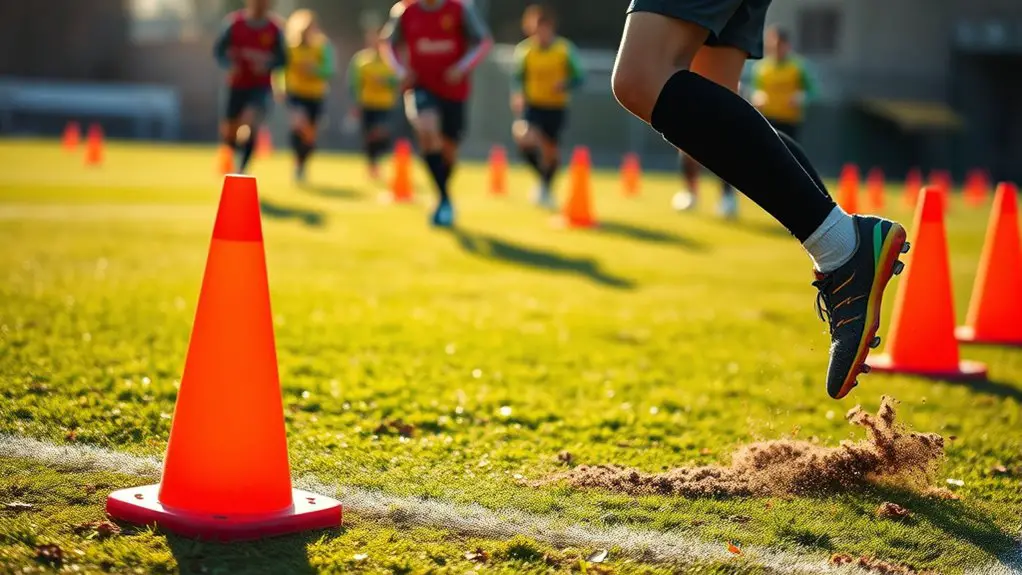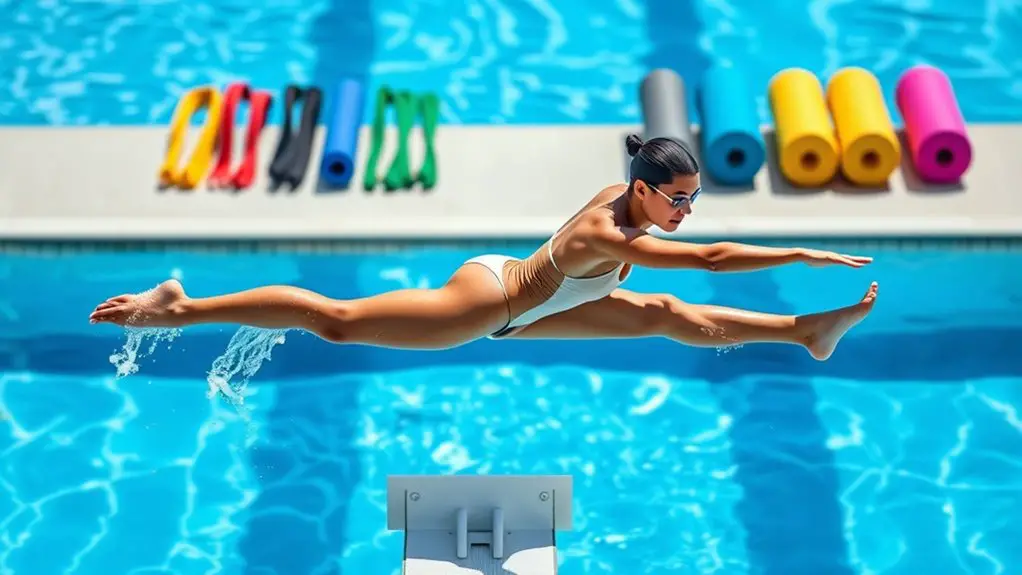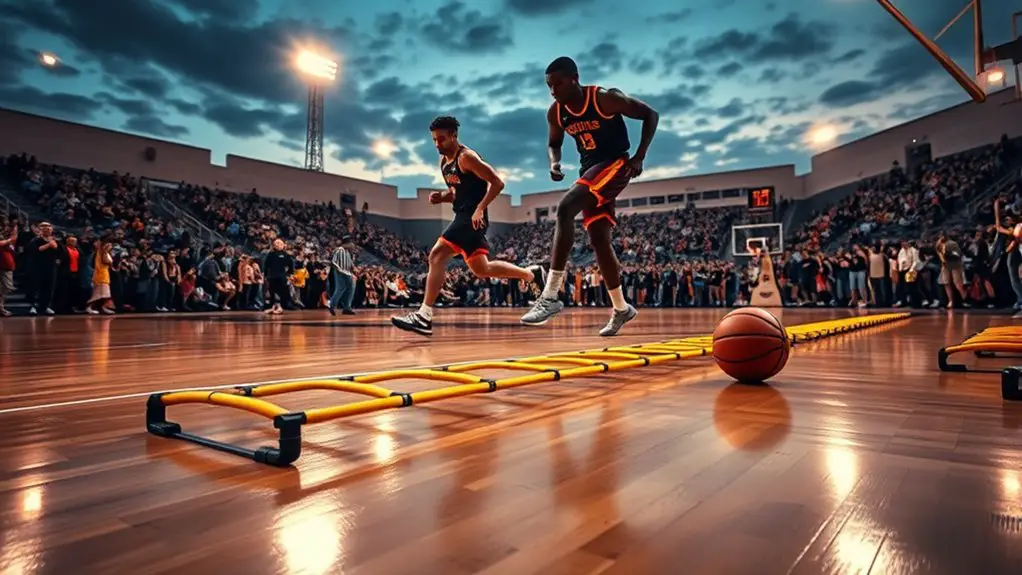To become a top defender, you need to focus on footwork drills that enhance agility and reaction time. Incorporate ladder drills for quick foot movements, cone drills for swift direction changes, and shadow drills to boost your response speed. Practice defensive slides for lateral movement, zigzag runs for acceleration, and shuttle runs to build endurance. Partner drills can also simulate real-game situations. Keep practicing, and you'll discover even more techniques to elevate your game.
Ladder Drills for Agility
Ladder drills are a fantastic way to enhance your agility as a defender. By integrating various ladder variations into your training, you'll develop quick footwork patterns that can make all the difference during gameplay. You can start with basic in-and-out steps, then progress to lateral movements and crossover steps. These drills help you feel more in control of your body, allowing for swift changes in direction.
Imagine weaving through an invisible opponent, your feet dancing with precision and speed. The beauty of ladder drills lies in their versatility; you can mix and match different patterns to keep things fresh and exciting. Plus, they're easy to set up anywhere, giving you the freedom to practice on your terms. So, grab that agility ladder and get ready to elevate your game. Your quickness and responsiveness will certainly shine, helping you outmaneuver any challenger on the field. Consistency in practicing agility ladder drills is key to unlocking your full potential on the field.
Cone Drills for Quick Direction Changes
While agility ladders enhance foot speed, cone drills are essential for mastering quick direction changes on the field. These exercises let you practice sudden stops and starts, helping you adapt to unpredictable game situations. To get the most out of your training, consider these aspects of cone placement and speed variation:
- Set cones in various patterns, like zigzags or circles, to challenge your agility.
- Start with slower speeds to focus on technique, then gradually increase intensity.
- Use different distances between cones to simulate real-game scenarios.
- Incorporate lateral movements and sharp turns to keep your footwork versatile.
Additionally, proper footwork during these drills can significantly reduce the risk of injuries.
Shadow Drills for Reaction Time
After honing your quick direction changes with cone drills, it's time to focus on enhancing your reaction time through shadow drills. These drills mimic game situations, allowing you to respond swiftly without the constraints of a partner. Start by visualizing an opponent's movements—whether they're feinting, sprinting, or changing direction. Use reaction exercises like sudden stops and quick pivots to sharpen your instincts.
To maximize your training, incorporate focus drills that require you to anticipate movements. Set up specific scenarios in your mind and react as if you're facing a real attacker. This not only boosts your reaction time but also builds confidence in your ability to read the game. Additionally, practicing mental alertness and awareness enhances your reaction time significantly, ensuring you remain sharp during competitive play.
Defensive Slide Drills for Lateral Movement
To be an effective defender, mastering the basic slide technique is essential for your lateral movement. Once you've got that down, you can challenge yourself with advanced lateral drills to enhance your agility. Let's explore how these exercises can elevate your defensive skills on the court or field. Additionally, incorporating strength training into your routine can significantly improve your muscle power for directional changes.
Basic Slide Technique
Mastering the basic slide technique is essential for any defender looking to improve lateral movement on the court. This technique starts with a solid basic stance, where you're balanced and ready to move. Proper foot placement is key to executing effective slides. Here are some tips to help you refine your technique:
- Keep your knees slightly bent for better agility.
- Position your feet shoulder-width apart for stability.
- Use short, quick steps to maintain speed and control.
- Always face your opponent, keeping your hips low and ready to react.
Advanced Lateral Drills
While basic slide techniques lay the foundation, incorporating advanced lateral drills can greatly elevate your defensive skills. These drills help you master advanced footwork techniques and agility enhancement strategies, allowing you to move fluidly while maintaining control.
Here's a simple breakdown of some effective advanced lateral drills:
| Drill Name | Description | Purpose |
|---|---|---|
| Lateral Cone Drill | Set up cones and slide between them | Improve lateral speed |
| Shadow Drill | Partner mimics your movements | Enhance reaction time |
| Slide and Sprint | Slide, then sprint in a direction | Combine agility and speed |
Integrate these drills into your routine, and you'll notice a significant boost in your defensive prowess. Stay free and fluid on the court!
Zigzag Runs for Acceleration
Zigzag runs are an excellent way to enhance your acceleration and agility on the field. By incorporating zigzag patterns into your training, you'll experience significant speed improvement while also honing your footwork. Here's how to set up your zigzag runs:
- Find a flat area and mark out a series of cones in a zigzag formation.
- Start at one end and sprint towards the first cone at an angle.
- Plant your foot and change direction quickly towards the next cone, keeping your body low.
- Focus on explosive movements for maximum acceleration.
As you practice, you'll notice how much more agile you become. Zigzag runs not only improve your speed but also help you develop quick decision-making skills when you need to change direction unexpectedly. Incorporating plyometric exercises into your training can further enhance your explosive power and overall acceleration. Embrace this drill, and watch your performance soar on the field!
Box Drills for Spatial Awareness
Building on the agility gained from zigzag runs, box drills can further enhance your spatial awareness on the field. These drills involve creating box formations where you'll move quickly from one corner to another, simulating real-game scenarios. As you navigate the box, you'll develop an instinct for positioning, helping you anticipate your opponent's moves and your teammates' needs.
To execute, set up a square with cones, spacing them about 5-10 yards apart. Start at one corner, and sprint to the next while maintaining control and balance. Add variations, like shuffling or backpedaling, to challenge yourself and adapt to different situations. Incorporating agility drills into your training can further sharpen your footwork and responsiveness.
Box drills sharpen your awareness, making you more dynamic and effective during gameplay. By improving your spatial awareness, you'll feel freer and more confident, allowing you to shine as a defender while moving fluidly within the game's rhythm.
T-Drills for Versatile Footwork
To enhance your footwork versatility, T-drills are a crucial addition to your training regimen. These drills improve your agility and help you adapt to different game scenarios. You can incorporate various T-drill variations and progressions to keep things fresh and challenging. Here are some key components to focus on:
- Acceleration: Start with a burst to mimic game situations.
- Change of Direction: Practice sharp cuts to improve lateral movement.
- Backward Movement: Don't forget to include backpedaling for defensive maneuvers.
- Reaction Time: Add a partner or cone for unpredictable movements.
Incorporating agility training into your routine can significantly enhance your overall performance on the court.
Shuttle Runs for Endurance and Speed
Shuttle runs are a fantastic way to boost your endurance and speed on the field. By mastering the technique, you can enhance your agility and quickness, which are essential for any defender. Additionally, incorporating hydration strategies during your training can help maintain energy levels throughout these drills. Let's explore the benefits these drills offer and how to execute them effectively.
Benefits of Shuttle Runs
While many exercises can enhance a defender's agility and stamina, shuttle runs stand out for their unique benefits. These drills not only improve your footwork but also boost your overall performance on the field. Here are some key shuttle run benefits that elevate your endurance training:
- Increased cardiovascular fitness: You'll build stamina for those high-intensity moments.
- Enhanced speed and agility: Quick changes in direction sharpen your reaction time.
- Improved lateral movement: Essential for defenders needing to stay agile against opponents.
- Mental toughness: Pushing through fatigue helps you develop resilience.
Incorporating shuttle runs into your routine can transform your game, giving you the edge you crave. Embrace the freedom of movement and watch your skills soar!
Technique for Success
Mastering the technique of shuttle runs can markedly enhance your endurance and speed on the field. To start, focus on your foot placement; make sure your feet land softly and directly beneath your body for ideal balance control. As you sprint forward, push off explosively, engaging your core and driving your knees up for power. When you pivot, maintain a low center of gravity to keep your balance intact. It's crucial to practice rapid direction changes while keeping your movements fluid. Don't forget to incorporate variations, like lateral shuttles, to build agility. With consistent practice, you'll find yourself covering ground faster, allowing your natural freedom to shine during the game. Embrace the hustle, and watch your performance soar!
Partner Drills for Real-Game Scenarios
When it comes to developing your defensive skills, partner drills can really ramp up your game by simulating real-life scenarios on the field. These drills not only enhance your footwork but also boost your partner communication and situational awareness. Here are some essential drills to try:
Enhance your defensive skills with partner drills that simulate real-game scenarios, improving footwork, communication, and situational awareness.
- 1-on-1 Marking: Practice staying tight on your partner while they attempt to evade you. Focus on quick foot movements and body positioning.
- Shadowing: Follow your partner as they change direction. This will sharpen your reaction time and help you anticipate their moves.
- Pressure and Cover: One partner attacks while the other practices positioning and support, enhancing your teamwork under pressure.
- Game Situations: Set up specific scenarios, like a corner kick or a fast break, to replicate in-game dynamics and refine your responses. Additionally, incorporating proper warm-ups can help reduce the risk of injuries while practicing these drills.
Frequently Asked Questions
How Often Should I Practice Footwork Drills Each Week?
How often should you practice footwork drills each week? It really depends on your goals and current skill level. Ideally, aim for at least three to four sessions to maintain practice consistency without overwhelming yourself. Incorporate these into your weekly schedule, allowing for rest and recovery. This way, you'll develop your skills while still enjoying the freedom of movement. Listen to your body, and adjust accordingly to find what works best for you.
What Shoes Are Best for Footwork Training?
Imagine dancing on a smooth stage; the right shoes can make or break your performance. When it comes to footwork training, lightweight shoes with breathable materials are essential. Look for rubber soles that grip various training surfaces, whether it's turf or hardwood. You'll feel more agile and free, allowing you to move fluidly in every drill. So, choose wisely, and your feet will thank you as you master those quick cuts and pivots!
Can Footwork Drills Improve My Overall Athletic Performance?
Absolutely, footwork drills can greatly boost your overall athletic performance. By focusing on agility enhancement and coordination improvement, you'll find yourself moving more fluidly and efficiently in any sport. These drills train your body to react quicker and more precisely, giving you that freedom to maneuver without hesitation. Plus, you'll notice increased confidence in your movements, which can elevate your play and overall enjoyment in athletic pursuits. So, get started and see the benefits!
How Long Should Each Drill Session Last?
When it comes to drill duration, aim for sessions lasting 30 to 45 minutes. This timeframe strikes a balance between intensity and effectiveness, allowing you to push yourself without burning out. You'll want to keep the session intensity high, focusing on quality over quantity. It's all about finding that sweet spot where you can challenge yourself while still enjoying the freedom to explore different movements and techniques. Listen to your body, and adjust as needed!
What Age Is Appropriate to Start Footwork Drills?
You might think there's a perfect age to start footwork drills, but the truth is, youth training can begin as early as 6 or 7 years old. Age recommendations vary, but it's about introducing fun and developing basic skills. At this stage, you want to foster a love for the game, so keep it light and engaging. As they grow, you can gradually intensify the drills to enhance their abilities and confidence.




